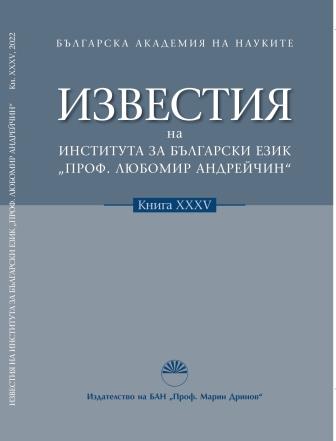ЗА СЪГЛАСУВAНЕТО И ВЗАИМОДЕЙСТВИЕТО НА НЯКОИ КАТЕГОРИИ С ОГЛЕД НА ФУНКЦИИТЕ НА ЕДИН
AGREEMENT AND THE INTERACTION OF SOME CATEGORIES IN RELATION TO THE FUNCTIONS OF EDIN (“ONE”)
Author(s): Christo StamenovSubject(s): Language studies, Language and Literature Studies, Theoretical Linguistics
Published by: Институт за български език „Проф. Любомир Андрейчин“, Българска академия на науките
Keywords: agreement (formal vs. semantic); functions of edin; fusion and fused heads; number; gender; quantified noun phrases; partitive quantifiers; Bulgarian
Summary/Abstract: The first part of this study discusses problems of agreement in number occurring with collective nouns, noun phrases with more than one modifier and quantified noun phrases, as well as gender agreement. The question of logical (semantic) vs. formal agreement as a dichotomy or a matter of degree of semantic justification is presented. Issues of language norm, variation and codification are also touched upon. The attention then turns to a specific case of wrong (semantic instead of formal) agreement in number of the relative pronoun and the verb in the relative clause in the expanded noun phrase edin ot Npl, koyto… (‘one of the N pl who…’) in the public speech of educated speakers of Bulgarian. This requires syntactic analysis of the examples, a look into the semantics of the Bulgarian preposition ot (‘from’ in this case is translated into English as of) and a reconsideration of the functions of edin in those constructions. Accepting the idea of fused heads (Huddleston & Pullum 2002) the author makes the tentative claim that in these constructions edin unites the functions of numeral, marker of specific indefiniteness and a pronoun. This goes against the current view that edin is split into homonymous forms: numeral, indefinite article, and (according to some analyses) indefinite pronoun. The reason for this apparent contradiction in the two approaches is the not fully completed process of grammaticalization of edin as an indefinite article in Present Day Bulgarian, described in detail in some recent publications. The approach advocated here is more in line with the ideas of gradability, prototype theory, and fuzzy categories, rather than the classical categorization in terms of necessary and sufficient conditions as criteria for categorization. The final part deals with the relationship between the categories of number and determination, peripherally, degrees of comparison, and their realization in the quantifying(X) and the quantified (Y) phrases in partitive construction with the Bulgarian preposition ot: X (edin/etc.) ot Y ‘X (one/etc.) of Y’, paying attention to the distinction between genuine and pseudo-partitive constructions.
Journal: Известия на Института за български език „Проф. Любомир Андрейчин"
- Issue Year: 2022
- Issue No: XXXV
- Page Range: 25-89
- Page Count: 64
- Language: English, Bulgarian

